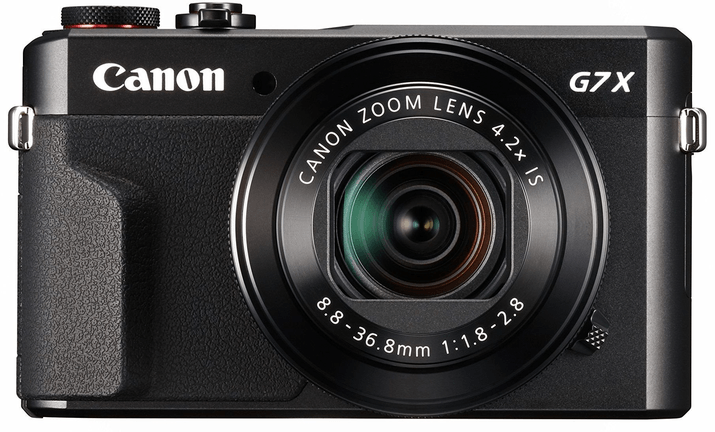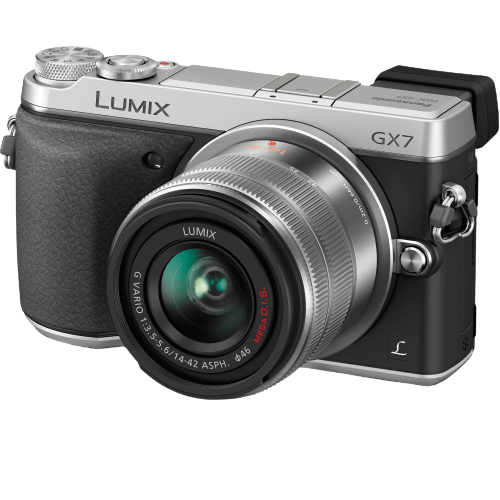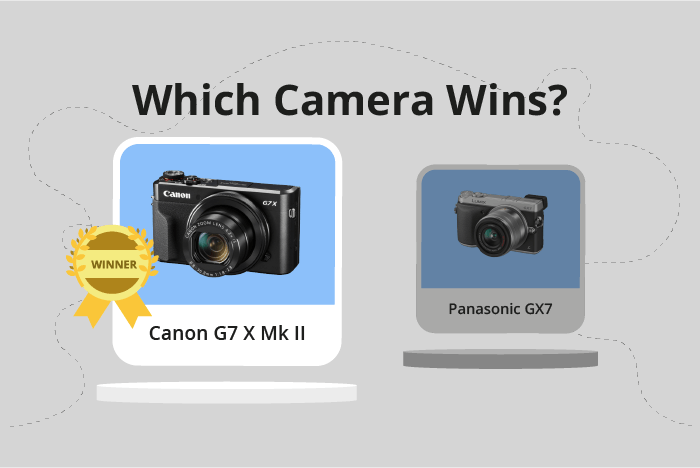Canon PowerShot G7 X Mark II vs Panasonic Lumix DMC-GX7 Comparison
Canon PowerShot G7 X Mark II

Panasonic Lumix DMC-GX7

The Canon PowerShot G7 X Mark II outperforms the Panasonic Lumix DMC-GX7 with a score of 59/100 versus 52/100. Both cameras share similarities, such as being released in the 2010s, with the Canon in 2016 and the Panasonic in 2013. Additionally, both are compact in size, with the Canon measuring 106x61x42mm and the Panasonic at 123x71x55mm.
The Canon G7 X Mark II excels with its lower launch price of $699 compared to the Panasonic’s $999, and lighter weight of 319g versus 402g. However, the Panasonic Lumix DMC-GX7 stands out as a mirrorless camera, while the Canon is a compact camera.
Taking into account the higher score, lower price, and lighter weight, the Canon PowerShot G7 X Mark II proves to be the better option between the two. The Panasonic Lumix DMC-GX7, though, offers the advantage of being a mirrorless camera for those who prioritize that feature.
Canon PowerShot G7 X Mark II vs Panasonic Lumix DMC-GX7 Overview and Optics
The Canon PowerShot G7 X Mark II wins the optics comparison with a score of 58/100, while the Panasonic Lumix DMC-GX7 scores 54/100. Both cameras share some common specifications, such as a CMOS sensor and an aspect ratio of 3:2 for the Canon and 4:3 for the Panasonic.
The Canon PowerShot G7 X Mark II has some advantages over the Panasonic Lumix DMC-GX7. It has a higher megapixel count of 20, compared to Panasonic’s 16, allowing for more detailed images. The Canon also has a faster shooting speed of 8 frames per second, which is ideal for capturing fast-moving subjects. Additionally, it has a better DXOMARK sensor score of 79, compared to Panasonic’s 70, indicating better overall image quality.
On the other hand, the Panasonic Lumix DMC-GX7 has some features that are better than the Canon PowerShot G7 X Mark II. The key advantage is its built-in image stabilization, which helps to reduce camera shake and produce sharper images. Additionally, the Panasonic has a Micro Four Thirds sensor size and a Micro 4/3 lens mount, allowing for interchangeable lenses, whereas the Canon uses a fixed lens mount.
After comparing the optics of both cameras, it is clear that the Canon PowerShot G7 X Mark II is the better choice for those seeking higher image quality and faster shooting speeds. However, the Panasonic Lumix DMC-GX7 may be more suitable for those who value image stabilization and the ability to change lenses. Each camera has its strengths and weaknesses, and the choice ultimately depends on the individual’s preferences and photography needs.
Canon PowerShot G7 X Mark II vs Panasonic Lumix DMC-GX7 Video Performance
The Canon PowerShot G7 X Mark II outperforms the Panasonic Lumix DMC-GX7 in video capabilities with a score of 70/100, compared to the Lumix’s 56/100. Both cameras share some common specifications, such as Full HD max video resolution, 1920 x 1080 max video dimensions, and a max video frame rate of 60fps. However, there are specific areas where each camera excels.
The Canon PowerShot G7 X Mark II has a built-in time-lapse functionality, which the Panasonic Lumix DMC-GX7 does not offer. This feature allows the Canon camera to capture sequences of images at set intervals and combine them into a single video, showcasing the passage of time in a creative and visually appealing manner. This advantage contributes to the Canon’s higher video score and makes it a more versatile choice for videographers interested in time-lapse photography.
On the other hand, the Panasonic Lumix DMC-GX7 does not have any notable advantages over the Canon PowerShot G7 X Mark II in terms of video capabilities. Both cameras share the same basic video specs, but the Lumix lacks the time-lapse functionality that sets the Canon apart. As a result, it falls short in the video department and receives a lower score.
Given the differences in video capabilities, the Canon PowerShot G7 X Mark II stands out as the better option for those prioritizing video performance. Its built-in time-lapse functionality offers creative possibilities that the Panasonic Lumix DMC-GX7 does not provide. While the Lumix may be a suitable choice for some, videographers should consider the Canon for its superior video features and higher score.
Canon PowerShot G7 X Mark II vs Panasonic Lumix DMC-GX7 Features and Benefits
The Canon PowerShot G7 X Mark II outperforms the Panasonic Lumix DMC-GX7 in features with a score of 70/100, compared to the Panasonic’s 57/100. Both cameras share common specifications, including a 3-inch screen size, a screen resolution of 1040000 dots, a touchscreen, a flip screen, no GPS, and WIFI capabilities. However, there are notable differences that set them apart.
The Canon PowerShot G7 X Mark II has an advantage with its Bluetooth connectivity, which the Panasonic Lumix DMC-GX7 lacks. This feature allows for easier file transfer and remote control functionality, making the Canon a more convenient choice.
On the other hand, the Panasonic Lumix DMC-GX7 does not have any distinct advantages over the Canon PowerShot G7 X Mark II in terms of features. Both cameras have the same screen size, resolution, and capabilities, making it a tie in these aspects.
Considering the features, the Canon PowerShot G7 X Mark II is the better choice due to its Bluetooth connectivity, which offers added convenience and functionality. The Panasonic Lumix DMC-GX7 does not provide any unique advantages and falls short in comparison to the Canon. Therefore, the Canon PowerShot G7 X Mark II is the superior option for those seeking a camera with more advanced features.
Canon PowerShot G7 X Mark II vs Panasonic Lumix DMC-GX7 Storage and Battery
The Canon PowerShot G7 X Mark II outperforms the Panasonic Lumix DMC-GX7 in storage and battery, with a score of 29/100 compared to 21/100. Both cameras have one memory card slot and accept SD, SDHC, and SDXC cards. However, the Canon model is UHS-I compatible, which allows for faster transfer speeds.
The G7 X Mark II has a battery life of 265 shots, while the GX7 lasts for 350 shots per charge. Despite the longer battery life of the GX7, the Canon camera takes the lead due to its USB charging capability. This feature makes it more convenient to charge the battery using a power bank or other USB sources.
On the other hand, the Panasonic Lumix DMC-GX7 has a longer battery life, which can be an advantage for users who prioritize shooting time. Nevertheless, the Canon PowerShot G7 X Mark II’s superior storage compatibility and USB charging option make it the better choice in this comparison.
Canon PowerShot G7 X Mark II vs Panasonic Lumix DMC-GX7 – Our Verdict
Are you still undecided about which camera is right for you? Have a look at these popular comparisons that feature the Canon PowerShot G7 X Mark II or the Panasonic Lumix DMC-GX7:

